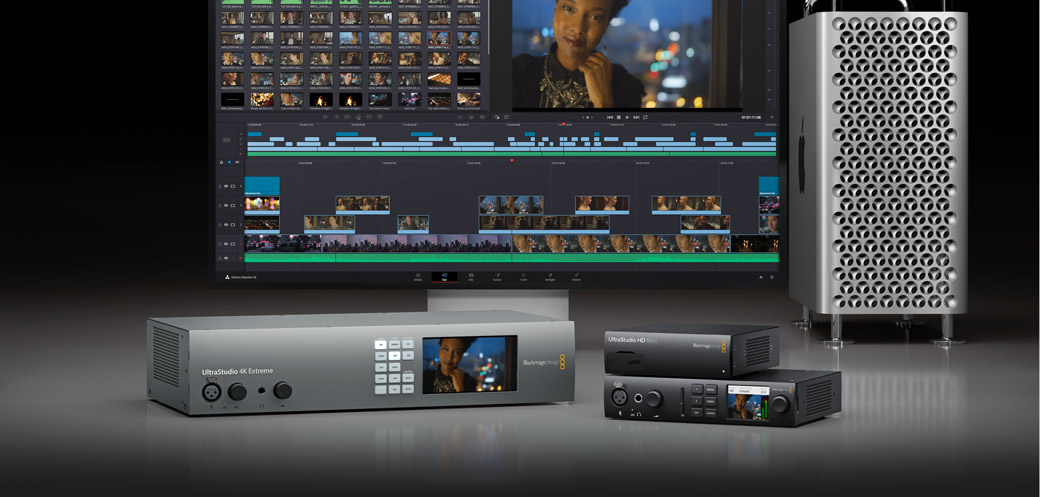
Blackmagic eGPU and Blackmagic eGPU Pro require a Mac with an Intel processor.
Created in close collaboration with Apple, Blackmagic Design's Blackmagic eGPU and Blackmagic eGPU Pro bring accelerated pro app workflows, smoother gameplay, and true-to-life VR content creation to your Mac.
Technical specifications
DeckLink Mini Recorder Record uncompressed 10-bit video from SDI and HDMI video sources. I need to connect a video camera through a Blackmagic UltraStudio Mini Recorder into Connect in a Mac. Import live and recorded video feeds to Mac computers using the Blackmagic Design UltraStudio Mini Recorder Hardware. Black Magic Websitehttps://www.blackmagicdesign.com/support/family/broadcast-and-atem-converters.
Blackmagic eGPU includes a Radeon Pro 580 graphics processor with 8GB DDR5 memory, giving your connected Mac graphics performance that's similar to a high-end 27-inch iMac.
Blackmagic eGPU Pro includes a Radeon RX Vega 56 graphics processor with 8GB HBM2 memory. This gives your connected Mac graphics performance that's similar to iMac Pro.
In addition to boosting graphics performance, both Blackmagic eGPUs provide 85 watts of charging power to MacBook Air and MacBook Pro.
Blackmagic eGPU has these ports to connect displays and VR accessories:
- Two Thunderbolt 3 (USB-C)
- Four USB 3.0
- One HDMI 2.0
Blackmagic eGPU Pro has these ports:
- Two Thunderbolt 3 (USB-C)
- Four USB 3.0
- One HDMI 2.0
- One DisplayPort 1.4

System requirements
Blackmagic eGPU is compatible with any Mac with an Intel processor and Thunderbolt 3 ports running macOS High Sierra 10.13.5 or later. Blackmagic eGPU Pro requires a Mac with an Intel processor and Thunderbolt 3 ports running macOS Mojave 10.14.1 or later.
If you have a Mac mini (2018) or Mac Pro (2019) with FileVault turned on, make sure to connect your primary display directly to your computer during startup. After you log in and see the macOS desktop, you can unplug the display from your computer and connect it to Blackmagic eGPU.
To connect Apple Pro Display XDR to Blackmagic eGPU or Blackmagic eGPU Pro, make sure your Mac is running macOS Catalina 10.15.2 and your eGPU has the latest firmware.
Here's how to update the firmware of your eGPU:
- Go to the Blackmagic website.
- Select the DaVinci Resolve, Fusion, and BlackMagic eGPU product family.
- Download and install the latest firmware for your eGPU.
Connect and use Blackmagic eGPU

When you connect Blackmagic eGPU or Blackmagic eGPU Pro to your Mac with a Thunderbolt 3 (USB-C) cable, the eGPU menu bar item appears, indicating that the eGPU is ready for use.
Blackmagic eGPU automatically accelerates the graphics from Metal-based apps on external displays and devices that are connected to the eGPU. You can use Activity Monitor to confirm that your eGPU is in use:
- Open Activity Monitor, which is in the Utilities folder inside Applications.
- Choose Window > GPU History. A graph appears, charting the activity of your computer's internal GPU and Blackmagic eGPU.
To disconnect Blackmagic eGPU, use the menu bar item to safely disconnect the eGPU from your Mac before unplugging the cable.
Use the 'Prefer external GPU' option

Starting with macOS Mojave 10.14, you can turn on 'Prefer external GPU' in a specific app's Get Info panel in the Finder. This option lets Blackmagic eGPU and Blackmagic eGPU Pro accelerate apps on any display connected to the Mac — including displays built in to the Mac:
- Quit the app if it's open.
- Select the app in the Finder. Most apps are in your Applications folder. If you open the app from an alias or launcher, Control-click the app's icon and choose Show Original from the pop-up menu. Then select the original app.
- Press Command-I to show the app's info window.
- Select the checkbox next to Prefer external GPU.
- Open the app to use it with the eGPU.
Learn more about using eGPUs with your Mac.
Learn more
macOS currently doesn't support eGPUs in Windows using Boot Camp or when your Mac is in macOS Recovery, at FileVault login, or installing system updates.
I have installed Windows 10 Pro with Bootcamp on both my iMac Pro1,1 2017 and Macbook Pro13,3 2016. The Blackmagic UltraStudio Mini Recorder is connected via the Apple USB-C Thunderbolt 2 adapter and works fine on OSx High Sierra and the Windows 10 Bootcamp on the Macbook Pro *** but not *** on the Bootcamp iMac Pro. The Mini Recorder ***light turns off*** right after the Windows 10 selection (boot) but does not turn back on seconds later (as it does on the Macbook Pro, hence works thereafter in the session). I have reinstalled both machines with no luck. I suspect there is a driver problem related to the USB-C hardware of the iMac Pro with the Bootcamp. Again, the mini recorder works fine on that machine using High Sierra, it's not a cable problem.
I have all latest drivers and Blackmagic software on both the Mac High Sierra system and the Bootcamp running Windows 10 Pro (I am an IT professional). I have tested the UltraStudio on another recent iMac (not the Pro) and it works on both environments. It's definitely a iMac Pro - Bootcamp issue with the power being cut on the Thunderbolt 3 (USB-C) right after the initial switch (option key) on the Windows partition. The UltraStudio light shuts down and does not come back (i.e. no power being sent to the USB-C) with Bootcamp. The power and connection works fine under the High Sierra partition.
Has anyone successfully used the UltraStudio mini Recorder on an iMac Pro running Windows 10 ? I am not sure it's a iMacPro specific driver problem with external USB-C power or a Blackmagic driver issue.
I need the Bootcamp-Windows 10 for reliability with OBS streaming with multi cams.
iMac Pro (2017), Windows 10, bootcamp
Ultrastudio Mini Recorder Driver Mac Big Sur
Posted on Sep 6, 2018 12:14 PM